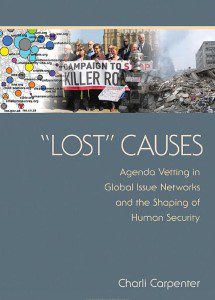 Just in time for you to head to the beach with a copy, my new book is now available from Cornell University Press.* As many of you know, this is the culmination of a my 6-year NSF-funded research project on why some human security problems get on the global agenda and others don’t. The answer in a nutshell: it’s all about what’s going on within the advocacy networks. A teaser of the first chapter is here. A nice write-up by the Chronicle of Higher Education is here.
Just in time for you to head to the beach with a copy, my new book is now available from Cornell University Press.* As many of you know, this is the culmination of a my 6-year NSF-funded research project on why some human security problems get on the global agenda and others don’t. The answer in a nutshell: it’s all about what’s going on within the advocacy networks. A teaser of the first chapter is here. A nice write-up by the Chronicle of Higher Education is here.
The book includes a longer version of the argument in this article, and three case studies on human security campaigns that I’ve followed and occasionally written about at the Duck – causes long championed by norm entrepreneurs but varying in their ability to gain traction on the global agenda:
- 1) The campaign for a new norm providing compensation to collateral damage victims. This idea that civilian war victims should be compensated by the militaries that harm them was the brainchild of humanitarian legend Marla Ruzicka, and has been cultivated over the years by the Center for Civilian Victims in Conflict (CIVIC) since Marla’s untimely death. Starting in 2007 I followed this group, documenting their efforts to get governments, generals, diplomats and humanitarian “gatekeepers” to take seriously the idea of “amends” for the lawful victims of military operations. Chapter Four tells that story up to 2011.
- 2) The campaign to ban autonomous weapons. Roboticist Noel Sharkey, and his colleagues, have been promoting this idea since 2007, but it gained salience on the international stage in 2012 when Human Rights Watch picked up the issue and launched a report on the topic. Now it is a full-fledged global campaign. Chapter Five tells the story of how norm entrepreneurs sold this concept to humanitarian disarmament elites despite opposition from counter-norm-entrepreneurs, and learned the art of transnational advocacy unexpectedly along the way.
- 3) The campaign to stop infant male circumcision. Although nearly three million baby boys are circumcised annually worldwide, often without anesthetic and primarily for cultural reasons, the practice has long been opposed by a grassroots transnational movement of health care practitioners, families, and children’s rights advocates. The cause has nonetheless received short shrift from the human rights movement, as Deb DeLaet has documented. Chapter Six examines “intactivist” efforts and agenda-vetting by human rights organizations and explores reasons for inattention to this bodily integrity rights issue by powerful actors in the human rights network.
Each of these cases illustrates the broader argument: that norm entrepreneurs must market their causes through human security “hubs” in order to succeed, and that their chances of doing so depend on social ties between actors, issues and subcultures within global issue networks. But each also tells a fascinating story of social change agents on the global front-lines, and the work they do each day to make our world a better place, often against great odds.
The chapter that may interest Duck readers the most is the methodologies appendix where I talk about the challenges of studying transnational spaces and detail the epistemological choices I made hanging out on the theory/policy divide. Therein, I explicitly take on Patrick Thaddeus Jackson’s typology of social science approaches and advocate a position on epistemological thresholds. Check it out, and let me know what you think.
______________
*(Or buy on Amazon, if you are not boycotting them at present).
Charli Carpenter is a Professor in the Department of Political Science at the University of Massachusetts-Amherst. She is the author of 'Innocent Women and Children': Gender, Norms and the Protection of Civilians (Ashgate, 2006), Forgetting Children Born of War: Setting the Human Rights
Agenda in Bosnia and Beyond (Columbia, 2010), and ‘Lost’ Causes: Agenda-Setting in Global Issue Networks and the Shaping of Human Security (Cornell, 2014). Her main research interests include national security ethics, the protection of civilians, the laws of war, global agenda-setting, gender and political violence, humanitarian affairs, the role of information technology in human security, and the gap between intentions and outcomes among advocates of human security.

I’ve just finished reading this book Charli and it’s great — it does an excellent job of elucidating what happens in that “black box” of intra-civil society agenda-setting, before issues break out into public discourse.